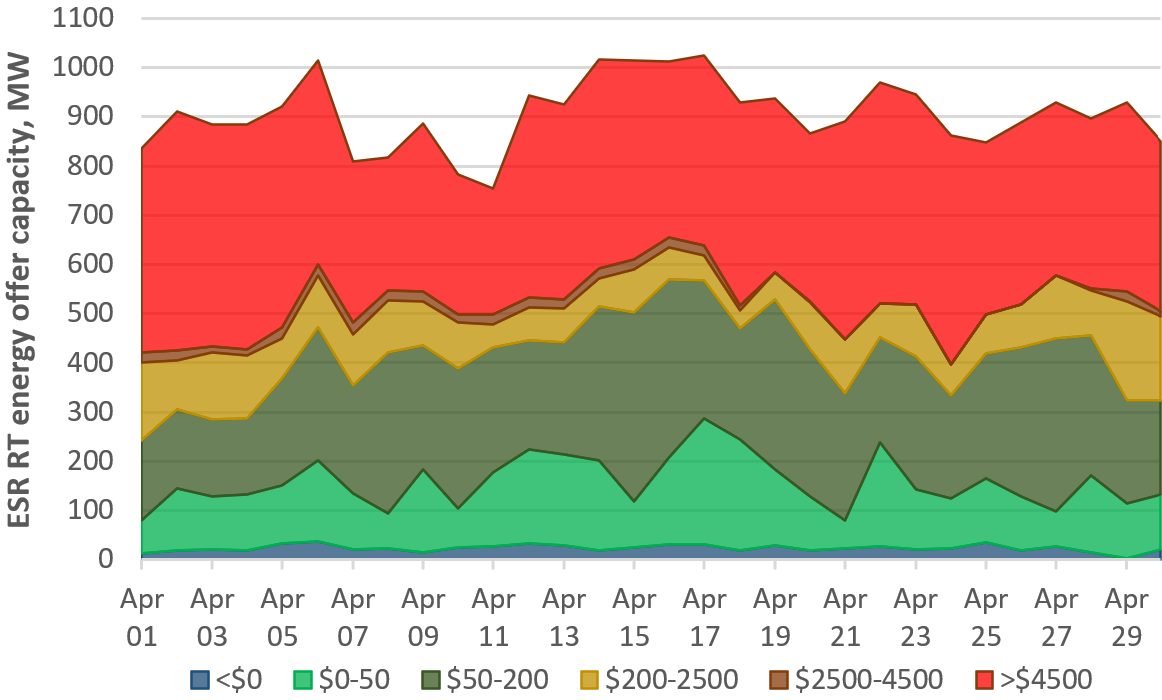Share this
ERCOT Real-Time SCED Gets Price Kicker from Batteries
by Alex Bennitt
This market driver alert (MDA) investigates four factors that contributed to high real-time pricing on June 20, 2023, in ERCOT.
ERCOT’s summer operations were tested in June 2023 when a prolonged heat wave settled over the state of Texas. The grid fared relatively well during a couple weeks of more than 75 GW peak loads, but on June 20, 2023, grid conditions got tight as net load peaked at 64.3 GW. Real-time (RT) settlement point prices (SPP) at North Hub peaked at $5,070.93/MWh.
What drove prices so high? Low generation available to real-time security constrained economic dispatch (SCED) required the clearing of energy offers from battery capacity with ultra-high offer prices.
Figure 1: Daily SCED real-time ESR energy offers by price level, April 2023, MW

In our MDA, we investigate:
- Energy storage resource (ESR) offers and capacity
- Capacity available to participate in the real-time market
- ERCOT resource outage capacity
- ERCOT’s Ancillary Service procurement
Want to learn more? Read the full MDA here.
Have questions or want to take a deeper dive into the data? Let's discuss how our transmission grid monitoring solution, Live Power®, could keep you a step ahead of market moves.
We are now delivering comprehensive 60-second power generation and transmission data covering California and the broader Western power markets through our Live Power® solution! Read more in our press release.
 About the author: Alex Bennitt is the product manager for Live Power and partner content integration at Yes Energy, where he utilizes a seven-year background in market fundamentals and Live Power operations to help steer product direction. In his free time, Alex is an avid skier who chases snow almost year-round.
About the author: Alex Bennitt is the product manager for Live Power and partner content integration at Yes Energy, where he utilizes a seven-year background in market fundamentals and Live Power operations to help steer product direction. In his free time, Alex is an avid skier who chases snow almost year-round.
Share this
- Industry News & Trends (122)
- Power Traders (86)
- Asset Managers (44)
- Asset Developers (35)
- ERCOT (35)
- Infrastructure Insights Dataset (35)
- Data, Digital Transformation & Data Journey (33)
- PowerSignals (30)
- Utilities (27)
- Market Events (26)
- Yes Energy Demand Forecasts (26)
- Market Driver Alerts - Live Power (25)
- DataSignals (24)
- Live Power (23)
- Renewable Energy (19)
- Risk Management (18)
- Data Scientists (17)
- Energy Storage / Battery Technology (17)
- ISO Changes & Expansion (17)
- CAISO (15)
- EnCompass (15)
- PJM (15)
- QuickSignals (12)
- SPP (10)
- MISO (9)
- Position Management (9)
- Power Markets 101 (9)
- Submission Services (8)
- Data Centers (7)
- Financial Transmission Rights (7)
- Demand Forecasts (6)
- Snowflake (6)
- FTR Positions Dataset (5)
- Powered by Yes Energy (5)
- Asset Developers/Managers (4)
- Geo Data (4)
- ISO-NE (4)
- Solutions Developers (4)
- AI and Machine Learning (3)
- Battery Operators (3)
- Commercial Vendors (3)
- GridSite (3)
- IESO (3)
- Independent Power Producers (3)
- NYISO (3)
- Natural Gas (3)
- data quality (3)
- Canada (2)
- Europe (2)
- Japanese Power Markets (2)
- PeopleOps (2)
- Crypto Mining (1)
- FERC (1)
- Ireland (1)
- PowerCore (1)
- Western Markets (1)
- hydro storage (1)
- nuclear power (1)
- November 2025 (3)
- October 2025 (7)
- August 2025 (4)
- July 2025 (6)
- June 2025 (5)
- May 2025 (5)
- April 2025 (10)
- March 2025 (6)
- February 2025 (11)
- January 2025 (7)
- December 2024 (4)
- November 2024 (7)
- October 2024 (6)
- September 2024 (5)
- August 2024 (9)
- July 2024 (9)
- June 2024 (4)
- May 2024 (7)
- April 2024 (6)
- March 2024 (4)
- February 2024 (8)
- January 2024 (5)
- December 2023 (4)
- November 2023 (6)
- October 2023 (8)
- September 2023 (1)
- August 2023 (3)
- July 2023 (3)
- May 2023 (4)
- April 2023 (2)
- March 2023 (1)
- February 2023 (2)
- January 2023 (3)
- December 2022 (2)
- November 2022 (1)
- October 2022 (3)
- September 2022 (5)
- August 2022 (4)
- July 2022 (3)
- June 2022 (2)
- May 2022 (1)
- April 2022 (2)
- March 2022 (3)
- February 2022 (6)
- January 2022 (2)
- November 2021 (2)
- October 2021 (4)
- September 2021 (1)
- August 2021 (1)
- July 2021 (1)
- June 2021 (2)
- May 2021 (3)
- April 2021 (2)
- March 2021 (3)
- February 2021 (2)
- December 2020 (3)
- November 2020 (4)
- October 2020 (2)
- September 2020 (3)
- August 2020 (2)
- July 2020 (2)
- June 2020 (1)
- May 2020 (8)
- November 2019 (1)
- August 2019 (2)
- June 2019 (1)
- May 2019 (2)
- January 2019 (1)




